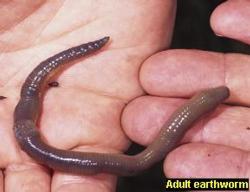Unused stories
Gardening Tips - Earthworms

“I doubt that there are many other animals which have played so important a part in the history of the world” said Charles Darwin of the earthworm. More descriptive perhaps, Aristotle called worms the “guts of the earth.” In either case, it is apparent that these little critters below our feet have been recognized for their valuable contribution for centuries. If you see lots of earthworms in your garden soil, be thankful and congratulations! It's a sign of healthy soil, one of the key elements in growing good plants.
Some interesting facts about earthworms:
- They’re nocturnal animals, classified as annelids
- They range from an inch to two yards in length, have a brain, are sensitive to taste, touch, light and vibration and breathe through their skin
- They’re mostly muscles and nerves - muscles run the length of the body as well as circling it
- They’re hermaphrodites, exhibiting both male and female characteristics
- Offspring can live for 10 – 12 years provided they aren’t found by a hungry bird, a gardener’s spade or pesticides in the soil
- They occur in most temperate and many tropical soils and are found seasonally at all soil depths
- They’re the dominant animal life in the soil; they can number several million to an acre of good soil
- They can eat their weight in decaying plant matter each day and bring 20 tons of soil to the surface each year
- Direct exposure to sunlight can be fatal to them in less than three minutes
For most gardeners, earthworms are a common site, and one to be encouraged. Look at all the good things they do to the soil - they mix and aggregate it, stimulate microbial activity, increase infiltration, improve water-holding capacity, provide channels for root quality, bury / shred residues, neutralize soil pH and improve overall soil quality.
There are two major types of earthworms – the deep-burrowers ("nightcrawlers") build large, vertical, permanent burrows that may extend five to six feet deep or more; they pull plant residues down into the mouth of their burrow, where the residues soften and can be eaten at a later time. The shallow-dwelling worms (commonly known as redworms, grayworms and fishworms) are comprised of many species that live primarily in the top twelve inches of soil. Adults usually live in the top few inches of soil, randomly burrowing, ingesting residues and mineral soil as they go.
Earthworms thrive best in moist, organic debris that contains a high percentage of nitrogen. Simply adding earthworms to poor soil won’t do much good. It’s pretty easy – just add organics when planting or mulching, and keep things watered – the worms will come.
Earthworms are truly the gardener’s best friend. And one last added benefit… they provide free fishing bait!
By Nanette Londeree
Photo courtesy of UC IPM website
